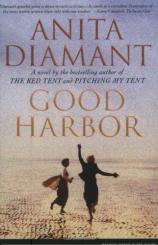Reading Group Guide
Discussion Questions
Good Harbor

1. Joyce and Kathleen become fast friends despite a seventeen-year age difference. What common traits, experiences, and challenges serve as the foundation of their friendship? How do their different perspectives on life help each other as wives, as parents, as friends, as women growing older?
2. Kathleen thinks that talking with men "just isn't the same." Do you agree? Is there an inherent difference in the way men and women communicate? What do Kathleen and Joyce derive from their conversations with each other that they don't get from their husbands?
3. How significant is the setting of this novel? How do Cape Ann and the beach at Good Harbor serve as "characters" or catalysts throughout the book?
4. Religion is an important theme for many characters in Good Harbor. How do Kathleen, Pat, Joyce, Hal, Rabbi Hertz, and Theresa Lupo, for example, approach their religion? How does religion help them define themselves? How does it bring them together?
5. Kathleen learns some surprising things about her son Hal in Good Harbor. How do these revelations affect their relationship? What does Kathleen learn about herself? About Hal?
6. Recall Kathleen's discomfort at friends offering their "cancer stories" when they learn of her diagnosis. Why do these sympathetic gestures make Kathleen feel worse rather than better? How does her sister Pat's death make Kathleen's diagnosis even more difficult to face?
7. What is the cause of Joyce's "funk" in the beginning of the novel? How does her house become both the outlet for her frustrations and a source of satisfaction?
8. Why does Joyce struggle between her desire to write a serious novel and her pleasure in writing about her romance heroine Magnolia? Why is she uncomfortable talking about her literary aspirations and accomplishments? What finally allows Joyce to get over her writer's block?
9. Kathleen says there are "lots of things she never said to Buddy" and believes this is "the secret of their marital happiness." Is she correct in that assessment? For Joyce and Frank, the lack of communication creates a deep rift in their relationship. What are some of the other silences and secrets in Good Harbor? What effect, both positive and negative, do they have on the characters' lives?
10. Kathleen and Buddy and Joyce and Frank experience different kinds of grieving over their children -- the first couple grieves a death, the second grieves the inevitable passage of their children into adulthood. How do these very different kinds of losses, and the couples' inability to talk about them, affect their marriages?
11. At the end of Good Harbor, Kathleen and Joyce have arrived at a new understanding of themselves, their families, and each other. Discuss the journey each woman makes to the new place in her life. What resources did they draw upon to get there? How do you imagine their futures?
12. If you have read Diamant's first bestselling novel, The Red Tent, compare and contrast it with Good Harbor. How does ancient womanhood differ from modern womanhood? What do Diamant's female characters have in common across the centuries?
Good Harbor
- Publication Date: September 17, 2002
- Genres: Fiction
- Paperback: 256 pages
- Publisher: Scribner
- ISBN-10: 0743225724
- ISBN-13: 9780743225724








